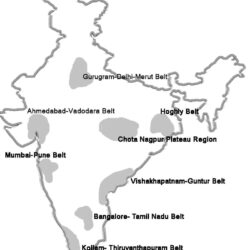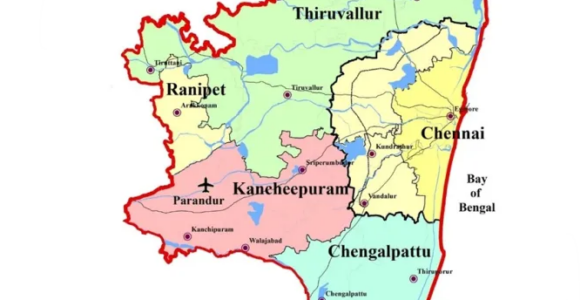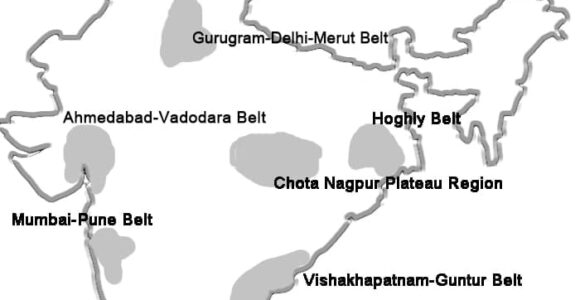
Industrial Regions
Industrial Regions: 8 Major Industrial Regions Of India
Following are the major industrial regions of India
- Mumbai-Pune Industrial Region
- Hugli Industrial Region.
- Bangalore-Tamil Nadu Industrial Region
- Gujarat Industrial Region
- Chotanagpur Industrial Region
- Vishakhapatnam-Guntur Industrial Region
- Gurgaon-Delhi-Meerut Industrial Region
- Kolfam-Thiruvananthapuram Industrial Region.
1. Mumbai-Pune Industrial Region:
This region extends from Thane to Pune and in adjoining districts of Nashik and Solapur. In addition, industries have grown at a rapid pace in Kolaba, Ahmednagar, Satara, Sangli and Jalgaon districts also. This region owes its origin to the British rule in India.
The seeds of its growth were sown in 1774 when the island-site was obtained for construction of Mumbai port. The opening of the first railway track of 34 kms between Mumbai and Thane in 1853, opening of the Bhor and Thai Ghats respectively to Pune and Nashik and that of Suez Canal in 1869 led to the development of Mumbai.
The growth of this industrial region is fully connected with the growth of cotton textile industry in India. As the coal was far removed, hydel power was developed in Western Ghats. Cotton was cultivated in the black cotton soil area of the Narmada and Tapi basins.
Cheap labour-force came from the hinterland, the port facilities for export-import and communication links with the peninsular hinterland made Mumbai the ‘Cottonopolis of India’. With the development of cotton textile industry, the chemical industry developed too.
Opening of the Mumbai High petroleum field and erection of nuclear energy plants added additional magnetic force to this region. Now the industrial centres have developed, from Mumbai to Kurla, Kolaba, Thane, Ghatkopar, Ville Parle, Jogeshwari, Andheri, Thane, Bhandup, Kalyan, Pimpri, Pune, Nashik, Manmad, Solapur, Ahmednagar, Satara and Sangli.
In addition to cotton textile and chemical industries, engineering goods, leather, oil refineries; petrochemicals, synthetic and plastic goods, chemicals, drugs, fertilizers, electricals, electronics, software, ship-building, transport and food industries have also developed here.
The partition of the country in 1947 adversely affected this region because 81% of the total irrigated cotton area growing long staple cotton went to Pakistan. Mumbai, the nucleus of this industrial region, is facing the current limitation of space for the expansion of the industry. Dispersal of industries is essential to bring about decongestion.
2. The Hugli Industrial Region:
Located in West Bengal, this region extends as a narrow belt running along the river Hugli for a distance of about 100 km from Bansbaria and Naihati in the north to Birlanagar in the south. Industries have also developed in Midnapur district in the west. The river Hugli offered the best site for the development of an inland river port as nucleus for the development of Hugli industrial region.
The old trading centre of late 17th century has developed into the present industrial hub of Kolkata. Thus Kolkata-Haora forms the nucleus of this region. It is very well- connected by the Ganga and its tributaries with the rich hinterland of Ganga-Brahmaputra plains. Besides navigable rivers, roads and the railways provided subsequent links to the great benefit of Kolkata port.
The discovery of coal and iron ore in Chotanagpur plateau, tea plantations in Assam and northern parts of West Bengal and the processing of deltaic Bengal’s jute led to the industrial development in this region. Cheap labour could be found easily from the thickly populated states of Orissa, Bihar, Jharkhand and eastern part of U.P. Kolkata, having been designated capital city of the British India (1773-1912) attracted large scale British investment of capital.
Establishment of first jute mill at Rishra in 1855 ushered in the era of modem industrial clustering in this region. A chain of jute mills and other factories could be established on either side of Hugli River with the help of Damodar valley coal. The port site was best-suited for export of raw materials to England and import of finished goods from that country.
Kolkata’s industries have established by drawing in the raw materials from adjoining regions and distributing the finished goods to consuming points. Thus, the role of transport and communication network has been as important as the favourable locational factors in the growth of this region. By 1921, Kolkata-Hugli region was responsible for two-thirds of factory employment in India.
Just after the partition of old Bengal province in 1947, the region faced, for some years, the problem of shortage of jute as most of the jute-growing areas went to East Pakistan (now Bangladesh). The problem was solved by gradually increasing home production of jute. Cotton textile industry also grew along with jute industry.
Paper, engineering, textile machinery, electrical, chemical, pharmaceuticals, fertilizers and petrochemical industries have also developed in this region. Factory of the Hindustan Motors Limited at Konanagar and diesel engine factory at Chittaranjan are landmarks of this region.
Location of petroleum refinery at Haldia has facilitated the development of a variety of industries. The major centres of this industrial region are Kolkata, Haora, Haldia, Serampur, Rishra, Shibpur, Naihati, Kakinara, Shamnagar, Titagarh, Sodepur, Budge Budge, Birlanagar, Bansbaria, Belgurriah, Triveni, Hugli, Belur, etc.
Alarming rate of silting of the Hugli River was a very serious problem. The depth of water in the channel from bay head to Kolkata docks must be kept at 9.2 metres for big ocean ships to come in. Dredging out of the silt rapidly filling up the water channel was very costly and not a permanent solution to save the life of Kolkata port.
The construction of Farakka barrage about 300 kms upstream on Ganga and flushing of the channel are the only possible answers. The construction of Haldia port in the lower reaches of Hugli to the south of Kolkata is another landmark in relieving the great pressure of cargo ships on the port of Kolkata.
However, the industrial growth of this region has slowed down as compared to the other regions. There are several reasons for this sluggish growth but decline in jute industry is said to be one of the main reasons.
3. Bangalore-Tamil Nadu Industrial Region:
Spread in two states of Karnataka and Tamil Nadu, this region experienced the fastest industrial growth in the post-independence era. Till 1960, industries were confined to Bangalore district of Karnataka and Salem and Madurai districts of Tamil Nadu. But now they have spread over all the districts of Tamil Nadu except Viluppuram.
This region is a cotton-growing tract and is dominated by the cotton-textile industry. In fact cotton textile industry was the first to take roots in this region. But it has large number of silk-manufacturing units, sugar mills, leather industry, chemicals, rail wagons, diesel engines, radio, light engineering goods, rubber goods, medicines, aluminium, cement, glass, paper, cigarette, match box and machine tools, etc.
This region is away from the main coal-producing areas of the country but cheap hydroelectric power is available from Mettur, Sivasamudram, Papanasam, Pykara and Sharavati dams. Cheap skilled labour and proximity to vast local market as well as good climate have also favoured the concentration of industries in this region.
Coimbatore has grown rapidly mainly owing to its industrial growth based on Pykara power, local cotton, coffee mills, tanneries, oil presses and cement works. Coimbatore is known as Manchester of Tamilnadu because of its large-scale cotton textile industry. The establishment of public sector units at Banglore like Hindustan Aeronautics, Hindustan Machine Tools, Indian Telephone Industry and Bharat Electronics etc. has further pushed up the growth of industries in the region.
Madurai is known for its cotton textiles. Visvesvarayya Iron and Steel Works is located at Bhadravati. The other important centres of this region are Sivakasi, Tiruchirapalli, Madukottai, Mettur, Mysore and Mandya. Petroleum refinery at Chennai and Narimanam and iron and steel plant at Salem are recent developments.
4. Gujarat Industrial Region:
The nucleus of this region lies between Ahmedabad and Vadodara as a result of which it is also known as Ahmedabad-Vadodara industrial region. However, this region extends upto Valsad and Surat in the south and Jamnagar in the west. The region corresponds to the cotton growing tracts of the Gujarat plains and the development of this region is associated with the location of textile industry since 1860s.
This region became important textile region with the decline of cotton textile industry in Mumbai. Mumbai has the disadvantage of paying double freight charges for first bringing the raw cotton from the peninsular hinterland and then despatching the finished products to inland consuming points in India.
But Ahmedabad is nearer the sources of raw material as well as the marketing centres of the Ganga and Satlui plains. Availability of cheap land, cheap skilled labour and other advantages helped the cotton textile industry to develop. This major industrial region of the country, mainly consisting of cotton textile industry, is expanding at a much faster rate in providing a greater factory employment.
The discovery and production of oil at a number of places in the Gulf of Khambhat area led to the establishment of petrochemical industries around Ankleshwar, Vadodara and Jamnagar. Petroleum refineries at Koyali and Jamnagar provide necessary raw materials for the proper growth of petrochemical industries.
The Kandla port, which was developed immediately after independence, provides the basic infrastructure for imports and exports and helps in rapid growth of industries in this region. The region can now boast of diversified industries.
Besides textiles (cotton, silk and synthetic fibres) and petrochemical industries, other industries are heavy and basic chemicals, dyes, pesticides, engineering, diesel engines, textile machinery, pharmaceuticads, dairy products and food processing. The main industrial centres of this region are Ahmedabad, Vadodara, Bharuch, Koyali, Anand, Khera, Surendranagar, Surat, Jamnagar, Rajkot and Valsad. The region may become more important in the years to come.
5. Chotanagpur Industrial Region:
As its name indicates, this region is located on the Chotanagpur plateau and extends over Jharkhand, Northern Orissa and Western part of West Bengal. The birth and growth of this region is linked with the discovery of coal in Damodar Valley and iron ore in the Jharkhand-Orissa mineral belt. As both are found in close proximity, the region is known as the ‘Ruhr of India’.
Besides raw materials, power is available from the dam sites in the Damodar Valley and the thermal power stations based on the local coal. This region is surrounded by highly populated states of Jharkhand, Bihar, Orissa and West Bengal which provide cheap labour.
The Kolkata region provides a large market for the goods produced in the Chotanagpur region. It also provides the port facility to the region. It has the advantages for developing ferrous metal industries. The Tata Iron and Steel Company at Jamshedpur, Indian Iron Steel Co., at Bumpur-Kulti, Hindustan Steel Limited at Durgapur, Rourkela and Bokaro are the important steel plants located in this region.
Heavy engineering, machine tools, fertilizers, cement, paper, locomotives and heavy electricals are some of the other important industries in this region. Important nodal centres of this region are Ranchi, Dhanbad, Chaibasa, Sindri, Hazaribagh, Jamshedpur, Daltonganj, Garwa and Japla.
6. Vishakhapatnam-Guntur Industrial Region:
This industrial region extends from Vishakhapatnam district in the north-eastern part of Andhra Pradesh to Kurnool and Prakasham districts in the south-east and covers most of the coastal Andhra Pradesh. The industrial development of this region mainly depends upon Vishakhapatnam and Machilipatnam ports.
Developed agriculture and rich mineral resources in the hinterlands of these ports provide solid base to the industrial growth in this region. Coal fields of the Godavari basin are the main source of energy. Hindustan Shipyard Ltd. set up at Vishakhapatnam, set up in 1941 is the main focus.
Petroleum refinery at Vishakhapatnam facilitated the growth of several petrochemical industries. Vishakhapatnam has the most modern iron and steel plant which have the distinction of being the only plant in India having coastal location. It uses high quality iron ore from Bailadila in Chhattisgarh.
One lead-zinc smelter is functioning in Guntur district. The other industries of this region include sugar, textiles, paper, fertilizers, cement, aluminium and light engineering. The important industrial centres of this region are Vishakhapatnam, Vijaywada, Vijaynagar, Rajahmundry, Kurnool, Elum and Guntur. Recent discovery of natural gas in Krishna- Godavari basin is likely to provide much needed energy and help in accelerated growth of this industrial region.
7. Gurgaon-Delhi-Meerut Industrial Region:
This region developed after independence, but is one of the fastest growing regions of India. It consists of two industrial belts adjoining Delhi. One belt extends over Agra-Mathura-Meerut and Saharanpur in U.P. and the other between Faridabad-Gurgaon- Ambala in Haryana.
The region is located far away from the mineral and power resources, and therefore, the industries are light and market oriented. The region owes its development and growth to hydro-electricity from Bhakra-Nangal complex and thermal power from Harduaganj, Faridabad and Panipat.
Sugar, agricultural implements, vanaspati, textile, glass, chemicals, engineering, paper, electronics and cycle are some of the important industries of this region. Software industry is a recent addition, Agra and its environs have glass industry. Mathura has an oil refinery with its petro-chemical complex. One oil refinery has been set up at Panipat also.
This will go a long way to boost the industrial growth of this region. Gurgaon has Maruti car factory as well as one unit of the IDPL. Faridabad has a number of engineering and electronic industries. Ghaziabad is a large-centre of agro-industries. Saharanpur and Yamunanagar have paper mills. Modinagar, Sonipat, Panipat and Ballabhgarh are other important industrial nodes of this region.
8. Kollam-Thiruvananthapuram Industrial Region:
This is comparatively small industrial region and spreads over Thiruvananthapuram, Kollam, Alwaye, Emakulam and Allapuzha districts of south Kerala. The region is located far away from the mineral belt of the country as a result of which the industrial scene here is dominated by agricultural products processing and market oriented light industries.
Plantation agriculture and hydroelectricity provide the industrial base to this region. The main industries are textiles, sugar, rubber, match box, glass, chemical fertilizers, food and fish processing, paper, coconut coir products, aluminium and cement. Oil refinery set up in 1966 at Kochi provides solid base to petrochemical industries. Important industrial centres are Kollam, Thiruvananthapuram, Alluva, Kochi, Alappuzha and Punalur.
Besides the above mentioned eight major industrial regions, India has 13 minor industrial regions and 15 industrial districts. Their names are mentioned below:
Minor Industrial Regions:
- Ambala-Amritsar in Haryana-Punjab.
- Saharanpur-Muzaffamagar-Bijnaur in Uttar Pradesh.
- Indore-Dewas-Ujjain in Madhya Pradesh.
- Jaipur-Ajmer in Rajasthan.
- Kolhapur-South Kannada in Maharashtra-Karnataka.
- Northern Malabar in Kerala.
- Middle Malabar in Kerala.
- Adilabad-Nizamabad in Andhra Pradesh.
- Allahabad-Varanasi-Mirzapur in Uttar Pradesh.
- Bhojpur-Munger in Bihar.
- Durg-Raipur in Chhattisgarh.
- Bilaspur-Korba in Chhattisgarh.
- Brahmaputra Valley in Assam.
Industrial Districts:
1. Kanpur, 2 Hyderabad, 3. Agra, 4. Nagpur, 5 Gwalior, 6. Bhopal, 7. Lucknow, 8. Jalpaiguri, 9. Cuttack, 10. Gorakhpur, 11. Aligarh, 12. Kota, 13. Pumia, 14. Jabalpur, 15. Bareilly.
Key Terms:
- Industrial Corridor ,
- Industrial Regions ,
- Infrastructure ,
- Metropolitan Region ,
- Transportation in India




